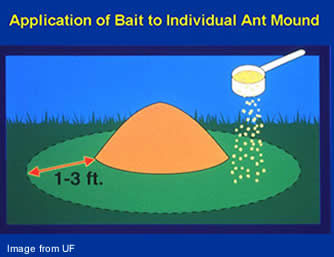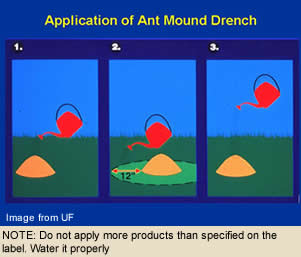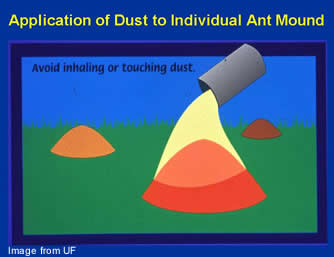Treatment methods and products vary greatly in effectiveness, speed of activity, practicality (labor requirements), toxicity to the user and the environment, compatibility with other options, and cost. Carefully study available treatment methods and their proper use to choose the best one for a particular situation. Many methods and products have been evaluated. Information is available from county Extension agents and Extension entomologists. Individual mound treatment costs range from about $0.15 to more than $1.00 per mound, and bait treatments can cost $10.00 per acre or more.
Natural and Biological Controls

Newly mated fire ant queens, which can start new colonies, are killed by several organisms. These include birds, lizards, spiders, toads, dragonflies, robber flies, other ant species and fire ants from surrounding colonies. In addition, animals that eat worker ants, such as armadillos, may disturb mounds to eat some workers, but they are not helpful in control.
The microorganism, Kneallhazia solenopsae, and parasitic phorid flies, Pseudacteon spp., also known as decapitating flies, have been introduced in Tennessee as biological control agents for imported fire ants. Kneallhazia has been most successful in the southern United States where multiple-queen colonies occur and is not commonly encountered in Tennessee. For instance, in 2017, Kneallhazia solenpsae was detected in 1% of Tennessee fire ant colonies sampled. In 2004, Pseudacteon curvatus was found in over 20 Tennessee counties and in 2007, it was found in over 50 counties. Not only do parasitized ants lose their heads and die, but the fly also disrupts the foraging of other workers. Diminished food returns may may weaken the colony.
Of the three RNA viruses (SINV-1, SINV-2, and SINV-3) known to occur in U.S. fire ants, SINV-1 has the most effect on stressed ants and SINV-2 is only found in male fire ants. On the other hand, SINV-3 has caused the most mortality in lab-reared ants and shows the most significant promise as a potential biocontrol agent or biopesticide. For up-to-date information on using these biological control organisms, see Using Natural Enemies to Control Fire Ants web page.
Another biological control option is preserving native and exotic ant species that compete with them for food and nesting sites, attack small fire ant colonies or kill newly-mated queen ants. One way to preserve native ants is through the judicious use of insecticides.
Chemical Control
Pesticides are products designed to kill target organisms. An insecticide is a pesticide formulated to kill insects. Using chemical insecticides (both “organic” and synthetic) continue to be the main method of battling fire ants. Insecticides registered by the EPA are considered to pose minimal risk to the user and the environment when used as directed. Insecticide applications can be aimed at the foraging ants and/or at the entire colony. Table 1 lists fire ant insecticides by generic names of active ingredients.
Baits
Most conventional bait formulations combine pesticide ingredients with soybean oil, which is absorbed onto processed corn grit. Soybean oil is an attractive food for ants that is important to the bait’s success. Because these baits are granular in texture, be careful not to confuse them with granular products that contain contact insecticides (see Table 1). Fire ant baits should have the word “BAIT” clearly listed on the label. Baits can be applied as spot treatments to individual mounds or broadcast over larger areas. To achieve satisfactory results:
- Use fresh bait, preferably from a recently opened container or one which is tightly resealed and stored for less than 2 years. Purchase only enough bait to make one treatment and do not store large quantities once the containers have been opened. Bait is collected by ants only when it is fresh. It is then carried back to the colony and shared with colony members. Foraging ants ignore rancid or stale bait. Rancid bait also often has a pungent, “latex paint” odor. To check the quality of your bait, place a little near an ant mound to see if ants are attracted to it.
- Apply when worker ants are actively foraging. Foraging activity can be determined by leaving a small pile, e.g., 1 to 2 tablespoons, of bait in the area to be treated. When ants are seen actively removing the bait 10 to 30 minutes later, you will know that the bait is attractive and ants are foraging. You can also use tuna fish, pet food or oily potato chips to see if ants are foraging. Foraging activity slows when soil temperature is lower than 65 to 70 degrees F or higher than 90 degrees F. In mid-summer, apply bait in late afternoon or early evening because foraging ants are less active during the heat of the day.
- Apply baits when the ground and grass are dry and no rain is expected.
- Do not mix bait with other materials such as fertilizer or seed.
- Use appropriate application equipment and calibrate it properly. Differences in the oiliness of bait brands and production batches can cause variations in applicator output. Temperature and humidity also affect bait flow through the applicator opening. The speed at which the applicator is moving is an important factor, particularly with factory-calibrated settings. Over-application provides little or no increase in control and adds greatly to the cost. Under-application may decrease effectiveness.

The availability of bait products is a problem, especially in areas recently invaded by the fire ant. If you cannot find some of the products mentioned in this publication, contact the store manager, visit your local co-op or contact your county Extension agent to determine if the product is available in your area. Some bait products are sold only through specialty stores such as lawn and garden supply stores or pesticide wholesalers that sell professional products.
Hand-operated spreaders such as the EarthWay® Ev-N-Spred and Scott’s® HandyGreen® are ideal for treating small areas with fire ant baits. The operator can walk or ride on the back of a vehicle. Some push-type applicators, such as Spyker® Models 24 and 44, also may be suitable, but some modification (attach fire ant plate) is required to keep from applying too much material. Most rotary and drop-type fertilizer spreaders will not apply fire ant baits at the recommended rate.
Electric spreaders such as the Herd® Model GT-77A or similar applicators best treat large areas. These spreaders have vibrating opening plates that prevent clogging. Swath width is either pre-set or adjustable with a rheostat. Applicators can be mounted on any vehicle that will maintain a low speed. Do not use ground-driven or power take-off-driven equipment, because it can rarely be set to apply the required low rate. Aerial application requires some modifications to the aircraft and application equipment. A description of these relatively simple modifications and calibration methods can be obtained from bait product manufacturers.
In addition to their use as a broadcast treatment, baits can be used for an individual mound treatment or spot treatment. Compared to other mound treatment products, baits cause less environmental hazard and less mound relocation. Some bait products (hydramethylnon) are available in bait stations that you place where ants are foraging (indoors or outdoors). Bait products containing indoxacarb, hydramethylnon, abamectin or spinosad used to treat individual ant colonies work faster than when broadcast-applied. This is, however, not the case with insect growth regulator (IGR) baits containing methoprene or pyriproxyfen. Apply bait products as directed on the product label.
Individual Mound Treatments with Contact Insecticides
In addition to baits, mound treatment insecticides are formulated as dusts, liquids, granules and aerosols. Their effectiveness depends on proper application. Contact insecticides must contact ants to work and should be applied during times of the year (and times of the day) when ants are close to the mound surface. It is also important not to disturb the mound during treatment if this is stated on the product label. Individual mound treatment selectively eliminates only the ant colonies treated, and preserves desirable competitor ant species.
Mound Drenches
Although a few are ready-to-use, most fire ant mound drenches are formulated as liquid concentrates that must be diluted in the amount of water specified on the label. Avoid skin contact with the concentrate or mixture. Mix the proper mount in a gallon container, such as a sprinkling can, plainly marked “POISON.” Do not use the container for any other purpose. Properly store or discard containers after use. Pour the solution on top of and around an undisturbed mound. Most mound drenches require a day or two to eliminate the colony, although those containing pyrethrins are effective almost immediately.
Granular Products
To treat a single mound with a granular product, measure the recommended amount in a measuring cup and sprinkle it on top of and around the mound. Do not disturb the mound. If the label specifies to water in the insecticide, use a sprinkling can and water the mound gently to avoid disturbing the colony. Several days may pass before the entire colony is eliminated.
Dusts
Some products, such as those containing acephate (Orthene®), are specially labeled for dusting individual fire ant mounds. Distribute the recommended amount of the powder evenly over the mound. Treatments work best when ants are near the top of the undisturbed mound. Treated colonies are usually eliminated in several days.
Injectable Products
Products containing pyrethrins, allethrin, tetramethrin or chlorpyrifos are manufactured in special aerosol containers to which an injection rod is attached. The rod is inserted into the mound in a number of places, according to instructions on the product label, and the pesticide is injected for a specified time into each mound.
Surface Applications and Barriers in and around Structures
Products used to treat ant trails and colonies in wall voids are usually dusts or sprays, although some are mixtures of insecticide and latex paint. Unless the colony itself is treated, these products only reduce the number of foraging worker ants. Surface treatments are also used to create barriers to protect items or areas from foraging worker ants.
Surface Applications Outdoors
Granular insecticides are applied with fertilizer spreaders. These materials must be thoroughly watered into the soil after application. Liquid formulations are applied with a high-volume hydraulic, hose-end or boom sprayer. Some contact insecticides are relatively long-acting (weeks to months), suppress foraging ants quickly, and prevent small mounds from becoming established. Through repeated use these treatments can eliminate colonies.
Organic Insecticides
Any chemical product sold with a claim that it kills fire ants must be registered by the Environmental Protection Agency (EPA) or approved by the appropriate state regulatory agency. Several products said to be “organic” (of natural origin) are currently marketed for fire ant control. All of these products are registered by the EPA as pesticides and some are very effective. However, they are not necessarily safer than other insecticides and should be used with care.
For more information on using organic insecticides see Organic Fire Ant Management or Fire Ant Treatment Organic Insecticides.
Policy Statement for Making Chemical Control Suggestions
Suggested pesticides must be registered and labeled for use by the Environmental Protection Agency and the appropriate state Department of Agriculture or regulatory agency. The status of pesticide label clearances is subject to change and may have changed since this was produced. County Extension agents and specialists are advised of changes as they occur. The USER is always responsible for the effects of pesticide residues, as well as for problems that could arise from drift or movement of pesticides from his property to that of others. Always read and follow carefully the instructions on the product label. The information given herein is for educational purposes only. Reference to commercial products or trade names is made with the understanding that no discrimination is intended and no endorsement by the participating states’ Cooperative Extension Service is implied.
Home Remedies
In addition to very hot or boiling water, other “home remedies” have been tried. While these methods sometimes appear to work, they rarely eliminate colonies. Usually, the ant colony simply moves to a new location because of the disturbance, or the queen and a few workers temporarily remain hidden underground.
Gasoline and other petroleum products do kill some fire ant colonies. However, petroleum products are dangerously flammable or explosive, kill grass and plants around the treated mounds, and can seriously pollute the soil and ground water. Use of petroleum products, solvents, battery acids, bleaches or ammonia products can be dangerous and is strongly discouraged, except when they are ingredients in a registered pesticide product accompanied by usage directions.
Soap solutions, cleaning products or wood ashes soaked into the mound are believed to remove the protective wax coating from the ants or suffocate them. Generally, their use is discouraged because they have not been proven effective or this use is not supported by the product(s) manufacturer. Recently, some recipes for solutions containing citrus oil and other ingredients have been shown to hold promise as a mound drench treatment. Citrus oil, containing a natural extract of citrus peels, d-limonene (active ingredient in Orange Guard Fire Ant Control), is toxic to fire ants.
Sprinkling grits or other solid food substances onto fire ant mounds is ineffective. In theory, the ants eat the grits, which then swell and rupture the ants’ stomachs. In fact, only the last larval stage of the fire ant is known to digest solid food. All adults feed only on liquids or greasy materials.
Physical and Mechanical Control
Pouring very hot or boiling water on a mound is a fairly effective treatment, particularly at times when ants are close to the mound surface, such as on a cool, sunny morning in the warmer seasons. Approximately 3 gallons of very hot (almost boiling) water poured on each mound will eliminate about 60 percent of the mounds treated. Be careful handling large volumes of hot water to prevent serious burns, and keep hot water off of desired plants and grass.
Sometimes it may be sufficient to move colonies away from sensitive areas such as gardens. Disturbing or knocking down mounds frequently will cause colonies to move. Some people believe shoveling one mound on top of another will force ants to kill each other, but this is not true.
Certain barriers can keep ants out of sensitive areas such as duck nesting boxes or greenhouse benches. Talcum powder and Teflon®-like tape or spray products can be used on vertical surfaces, but these treatments lose their effectiveness in humid or damp conditions. Tanglefoot®, a petroleum-based sticky material available as a gel or aerosol, is effective temporarily until it becomes coated with dust and other debris. Plates or wires heated to about 140 degrees F form a hot barrier that ants will not cross.
Control Devices
Various mechanical and electrical products have been marketed for fire ant control. One device is designed to electrocute fire ant workers as they climb onto an electric grid inserted into the mound. It will kill many worker ants, but the queens and brood are unaffected. There have been vibrating and sound-producing units designed to repel colonies and devices that use microwaves or explosive elements to heat mounds or blow them up. Such products are often marketed without scientific evaluation. The fact that a “control” device is on the market does not indicate that it is effective. These products may kill some ants but rarely eliminate a colony. Deceptive or fraudulent claims concerning fire ant control devices should be reported to the state’s Attorney General or the Federal Trade Commission.


